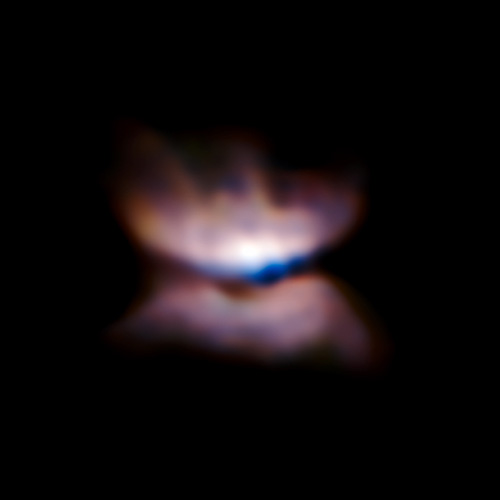Some of the sharpest images ever made with ESO’s Very Large Telescope (VLT) have, for the first time, revealed what appears to be an ageing star giving birth to a butterfly-like planetary nebula. These observations of the red giant star L2 Puppis, from the ZIMPOL mode of the newly installed SPHERE instrument, also clearly showed a close companion. The dying stages of stars continue to pose astronomers with many riddles, and the origin of such bipolar nebulae, with their complex and alluring hourglass figures, doubly so. This new imaging mode means that the VLT is currently the sharpest astronomical direct imaging instrument in existence.
Some of the sharpest images ever made with ESO’s Very Large Telescope have for the first time revealed what appears to be an ageing star in the early stages of forming a butterfly-like planetary nebula. These observations of the red giant star L2 Puppis from the ZIMPOL mode of the newly installed SPHERE instrument also reveal a close companion. The dying stages of the lives of stars continue to pose many riddles for astronomers. Crédit: ESO/P. Kervella
Read the press release from ESO
This research was presented in a paper entitled “The dust disk and companion of the nearby AGB star L2 Puppis”, by P. Kervella, et al., to appear in the journal Astronomy & Astrophysics on 10 June 2015.
The team is composed of P. Kervella (Unidad Mixta Internacional Franco-Chilena de Astronomía, CNRS/INSU, France; Departamento de Astronomía, Universidad de Chile, Santiago, Chile; Observatoire de Paris, LESIA, France; Université Paris-Diderot, Meudon, France), M. Montargès (LESIA, France; Institut de Radio-Astronomie Millimétrique, St Martin d’Hères, France), E. Lagadec (Laboratoire Lagrange, Université de Nice-Sophia Antipolis, CNRS, Observatoire de la Côte d’Azur, Nice, France), S. T. Ridgway (National Optical Astronomy Observatories, Tucson, Arizona, USA), X. Haubois (ESO, Santiago, Chile), J. H. Girard (ESO, Chile), K. Ohnaka (Instituto de Astronomía, Universidad Católica del Norte, Antofagasta, Chile), G. Perrin (Observatoire de Paris, LESIA, France) and A. Gallenne (Universidad de Concepción, Departamento de Astronomía, Concepción, Chile).






